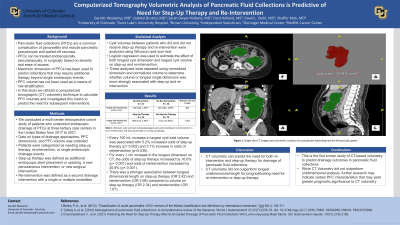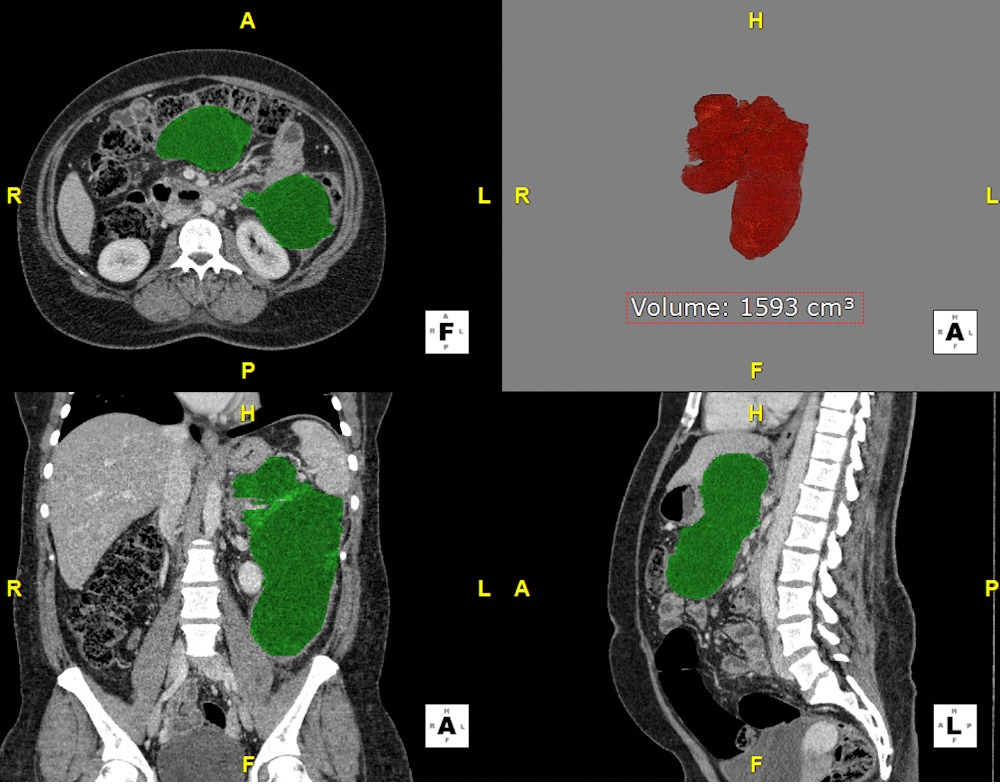Monday Poster Session
Category: Biliary/Pancreas
P1435 - Computerized Tomography Volumetric Analysis of Pancreatic Fluid Collections Is Predictive of Need for Step-Up Therapy and Re-Intervention
Monday, October 23, 2023
10:30 AM - 4:15 PM PT
Location: Exhibit Hall

Has Audio

Garrett Weskamp, MD
University of Colorado
Cleveland Heights, OH
Presenting Author(s)
Award: Presidential Poster Award
Garrett Weskamp, MD1, Gabriel Brutico, MD, MBS2, Sarah Dwyer Holland, MD, MS3, Ford Holland, MS4, David L. Diehl, MD5, Shaffer Mok, MD, MBS6
1University of Colorado, Aurora, CO; 2Saint Luke’s University Hospital, Bethlehem, PA; 3Brown University, Providence, RI; 4Independent Researcher, Providence, RI; 5Geisinger Medical Center, Danville, PA; 6Moffitt Cancer Center, Tampa, FL
Introduction: Pancreatic fluid collections (PFCs) are a common complication of pancreatitis, and can be treated endoscopically, percutaneously, or surgically. Maximum dimension of PFCs has been used to predict collections that may require additional therapy beyond single endoscopic events. However, PFC volume has not been used as a means of risk-stratification. In this study we utilized a computerized tomographic volumetry technique to calculate PFC volumes and investigated this metric to predict the need for subsequent interventions.
Methods: We conducted a multi-center retrospective cohort study of patients who underwent endoscopic drainage of PFCs at three tertiary care centers in the United States from 2017 to 2021. Data on types of drainage approaches, PFC dimensions, and PFC volume was collected. Patients were categorized as needing step-up therapy, re-intervention, or single endoscopic drainage events. Differences in the largest cyst volume between patients who did and did not receive step-up therapy and re-intervention were analyzed using Wilcoxon rank sum test. Logistic regression was used to estimate the effect of both longest cyst dimension and largest cyst volume on step-up therapy and re-intervention. These analyses were repeated using normalized dimension and normalized volume to determine whether volume or longest single dimension was more strongly associated with reintervention and step-up therapy.
Results: A total of 117 patients were identified: of these, 35.9% required step-up therapy and 52.1% required re-intervention. Every 100 mL increase in volume was associated with 5.2% increased odds of step-up therapy (p= 0.002) and 3.1% increase in odds of reintervention (p=0.036). For every 1 cm increase in the longest dimension on CT, the odds of step-up therapy increased by 16.6% (p< 0.001) and odds of reintervention increased by 20.8% (p< 0.001). There was a stronger association between longest dimensional length on step-up therapy (OR 2.42) and reintervention (OR 2.98) compared to volume on step-up therapy (OR 2.34) and reintervention (OR 1.67).
Discussion: CT Volumetry can predict the need for additional drainage procedures in patients with PFCs. Although this data shows a stronger relationship between unidimensional length and the likelihood of these additional drainage events, CT volumetry can be used to predict intervention strategies in more irregularly shaped collections and should be subject of future related research.

Disclosures:
Garrett Weskamp, MD1, Gabriel Brutico, MD, MBS2, Sarah Dwyer Holland, MD, MS3, Ford Holland, MS4, David L. Diehl, MD5, Shaffer Mok, MD, MBS6. P1435 - Computerized Tomography Volumetric Analysis of Pancreatic Fluid Collections Is Predictive of Need for Step-Up Therapy and Re-Intervention, ACG 2023 Annual Scientific Meeting Abstracts. Vancouver, BC, Canada: American College of Gastroenterology.
Garrett Weskamp, MD1, Gabriel Brutico, MD, MBS2, Sarah Dwyer Holland, MD, MS3, Ford Holland, MS4, David L. Diehl, MD5, Shaffer Mok, MD, MBS6
1University of Colorado, Aurora, CO; 2Saint Luke’s University Hospital, Bethlehem, PA; 3Brown University, Providence, RI; 4Independent Researcher, Providence, RI; 5Geisinger Medical Center, Danville, PA; 6Moffitt Cancer Center, Tampa, FL
Introduction: Pancreatic fluid collections (PFCs) are a common complication of pancreatitis, and can be treated endoscopically, percutaneously, or surgically. Maximum dimension of PFCs has been used to predict collections that may require additional therapy beyond single endoscopic events. However, PFC volume has not been used as a means of risk-stratification. In this study we utilized a computerized tomographic volumetry technique to calculate PFC volumes and investigated this metric to predict the need for subsequent interventions.
Methods: We conducted a multi-center retrospective cohort study of patients who underwent endoscopic drainage of PFCs at three tertiary care centers in the United States from 2017 to 2021. Data on types of drainage approaches, PFC dimensions, and PFC volume was collected. Patients were categorized as needing step-up therapy, re-intervention, or single endoscopic drainage events. Differences in the largest cyst volume between patients who did and did not receive step-up therapy and re-intervention were analyzed using Wilcoxon rank sum test. Logistic regression was used to estimate the effect of both longest cyst dimension and largest cyst volume on step-up therapy and re-intervention. These analyses were repeated using normalized dimension and normalized volume to determine whether volume or longest single dimension was more strongly associated with reintervention and step-up therapy.
Results: A total of 117 patients were identified: of these, 35.9% required step-up therapy and 52.1% required re-intervention. Every 100 mL increase in volume was associated with 5.2% increased odds of step-up therapy (p= 0.002) and 3.1% increase in odds of reintervention (p=0.036). For every 1 cm increase in the longest dimension on CT, the odds of step-up therapy increased by 16.6% (p< 0.001) and odds of reintervention increased by 20.8% (p< 0.001). There was a stronger association between longest dimensional length on step-up therapy (OR 2.42) and reintervention (OR 2.98) compared to volume on step-up therapy (OR 2.34) and reintervention (OR 1.67).
Discussion: CT Volumetry can predict the need for additional drainage procedures in patients with PFCs. Although this data shows a stronger relationship between unidimensional length and the likelihood of these additional drainage events, CT volumetry can be used to predict intervention strategies in more irregularly shaped collections and should be subject of future related research.

Figure: CT scan with pericolic extension of pseudocyst and 3-D volumetric rendering
Disclosures:
Garrett Weskamp indicated no relevant financial relationships.
Gabriel Brutico indicated no relevant financial relationships.
Sarah Dwyer Holland indicated no relevant financial relationships.
Ford Holland indicated no relevant financial relationships.
David Diehl: Boston Scientific – Consultant. Castle – Consultant. Laborie – Consultant. Merit Endotek – Consultant. Microtech – Consultant. Olympus – Consultant. OnePass Medical – Consultant. Pentax – Consultant. Steris – Consultant.
Shaffer Mok: Conmed – Consultant. Steris – Consultant.
Garrett Weskamp, MD1, Gabriel Brutico, MD, MBS2, Sarah Dwyer Holland, MD, MS3, Ford Holland, MS4, David L. Diehl, MD5, Shaffer Mok, MD, MBS6. P1435 - Computerized Tomography Volumetric Analysis of Pancreatic Fluid Collections Is Predictive of Need for Step-Up Therapy and Re-Intervention, ACG 2023 Annual Scientific Meeting Abstracts. Vancouver, BC, Canada: American College of Gastroenterology.


